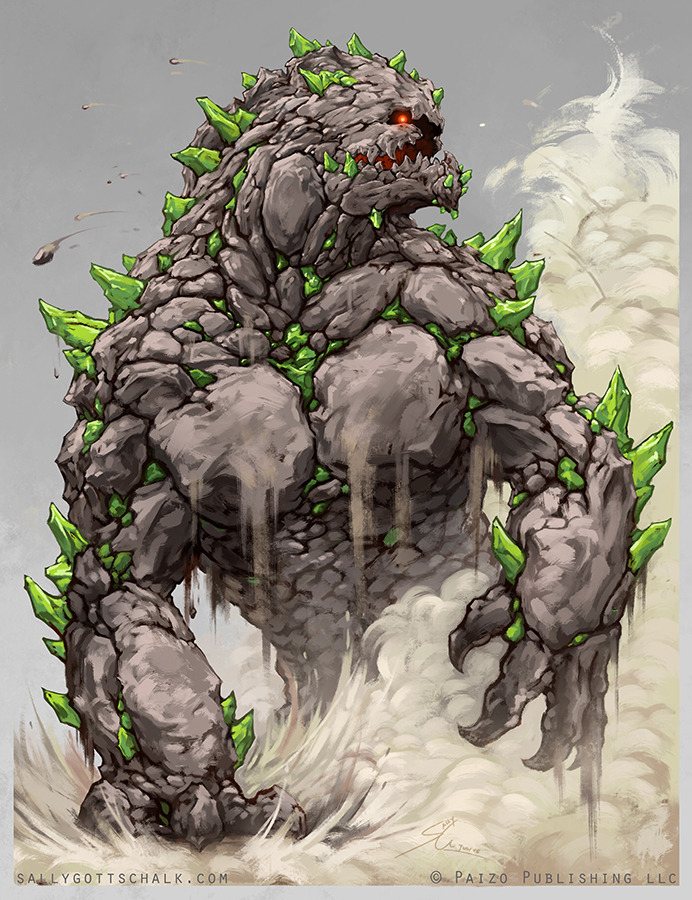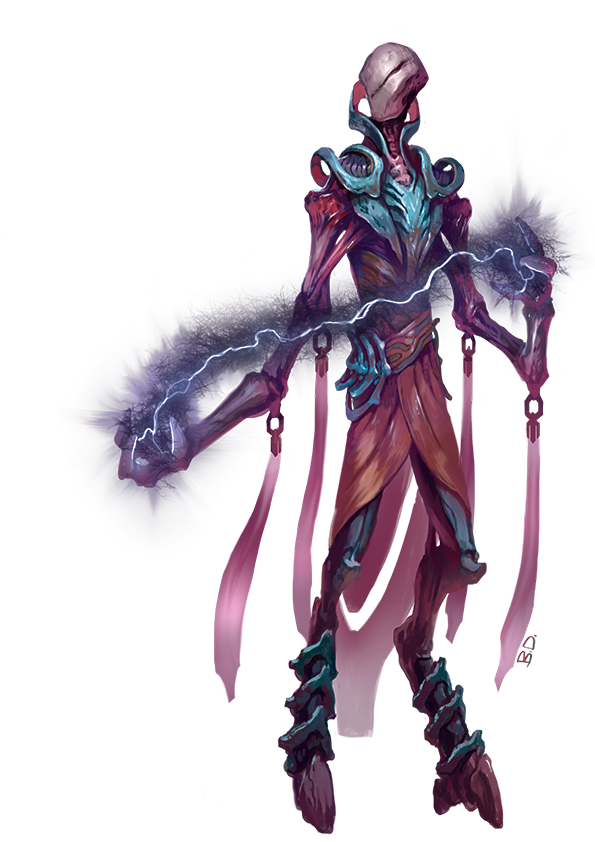Sarmak

“The War of the Worlds: The Martian” © Les Edwards, accessed at his site here
[The War of the Worlds needs no introduction. H.G. Wells’ novel is one of the first of the alien invasion sub-genre of science fiction, and still one of the best. It’s had multiple high profile adaptations, but for my money the best of them is Jeff Wayne’s Musical Version of The War of the Worlds. It’s the most faithful to Wells’ themes of colonialism, evolution and ecology.
The name “Sarmak” for the Martians comes from the book War of the Worlds: Global Dispatches, a collection of short stories inspired by The War of the Worlds and often crossing over with other public domain vintage SF. “Sarmak” is what the Barsoomians call these Martians, for instance. I like it, because Mars is of course an Earth name for the planet, plus it allows GMs to distance these monsters from Mars if they don’t want to open up that whole can of worms in their campaigns.
The development of the stat block for the sarmak was fun, because I went in a direction I (and Pathfinder in general) usually avoids. I n order to reflect their great knowledge and technological prowess, I wanted my Martians to have high HD for the skill points, but low physical ability scores. And, of course, statistics for the Fighting Machines/Tripods are forthcoming.]
Sarmak
CR 3 LE Aberration
This heaving bulk is larger than a bear, glistening like
wet leather. Its V-shaped mouth is toothless and drooling, with a pair of black
eyes glaring from above it. It has sixteen tentacles—eight larger ones on which
is drags itself and eight smaller ones that seem able to manipulate objects.
Sarmaks are technologically adept creatures from a dying desert world, and they watch resource-rich planets with envious eyes. Their colonial fleets consist of meteor-like drop ships, launched at a planet as a one way trip. Once on the surface, the sarmaks assemble deadly weapons made on their home world and shipped in pieces such as their savage heat rays, choking black smoke canisters, and their fearsome fighting machines. These tripodal robots each are piloted by a single sarmak but is more than a match for an entire army. Sarmaks believe in total warfare, targeting civilian populations and infrastructure in order to cripple resistance. Once established, they begin to convert their territory to their liking through ground cover plants (the pernicious “red weed”), and harvest both the land and the people in it for resources.
Sarmak physiology may once have been humanoid, but they have long since evolved away from physical strength, preferring to create artificial bodies for various needs using technology. A sarmak’s body is adapted for life on their planet, where gravity is fairly low—although they stride on the tips of their tentacles on their home world, they drag themselves along in the gravity of most planets. Likewise, their single ear is a tympanic membrane stretched across the back of their head, but it works best in thinner atmospheres, so sarmaks tend to be a trifle deaf, and shout loudly to each other in their colonies. Even the dullest sarmak is a genius by human standards. Their digestive systems are atrophied, and they feed by injecting the blood of other creatures directly into their veins.
A sarmak’s body is about four feet high and eight feet long. Their tentacles stretch another six to eight feet. They are long lived by human standards, surviving into their 200th year easily if not slain by violence or disease. Despite all of their technological prowess, sarmaks are vulnerable to a variety of pathogens. On their home world, they exterminated the microbes that cause diseases through chemical warfare, but this has left them prone to infection elsewhere.
Sarmak Technology
Biolocked devices
Knowing that their
machines falling to enemy hands is one of the biggest threats to sarmak
invasions, sarmak engineers have devised ways to render them inoperable to
other creatures. Crafting a biolocked device requires an extra day of work, and
increases the DC of any check made to craft the device by +2, but does not add
to the cost. A biolocked device works only for a sarmak (or other species
creating the biolocked device), unless the wielder succeeds a Knowledge
(engineering) check equal to the DC to craft the weapon. Success on this check
renders it operable for 24 hours by creatures of the new wielder’s species, or
of a species determined by the creature that succeeded the check. A roll of
natural 20 renders the device able to be wielded by any creature for 24 hours,
and a natural 1 renders the device unable to be used by any creature other than
a sarnak, or able to be reprogrammed to be used by other creatures, for the
next 24 hours.
Exsanguinator Rig
Price 2,000 gp; Slot none; Weight 8 lbs; Capacity 10 charges; Usage 1
charge/minute
Although sarmaks
usually take their time to drain the blood from sedated and bound captives, the
exsanguinator rig is used in order to quickly extract blood from struggling
victims or in combat by particular strong or sadistic sarmaks. This device
consists of multiple needles attached to hoses and piping, feeding into a large
central reservoir. When a charge is spent, actuators inside the device apply
negative pressure, sucking fluids from the needles into the reservoir. If an
exsanguinator rig is applied to a grappled, paralyzed or stunned creature, it drains
blood at a rate of 1d4 points of Constitution damage a round (Fort DC 15 halves the damage).
The weight given is for an empty rig; the central chamber can hold a gallon of
liquid at a time. An exsanguinator rig requires two hands to use.
Construction
Craft DC 25; Cost 1,000 gp
Craft Technological
Item, production lab
Sarmak CR
3
XP 800
LE Large aberration
Init +4; Senses darkvision 60
ft., Perception +13
Defense
AC 14, touch 9, flat-footed 14 (-1 size, +5 natural)
hp 35 (10d8-10)
Fort +2, Ref +3, Will +8; -2 vs. disease
Weakness immunodeficiency
Offense
Speed 20 ft., low gravity adaptation
Melee tentacles +6 (1d4 plus grab)
Ranged laser pistol +6 touch (1d8 fire)
Space 10 ft.; Reach 5 ft. (10 ft.
with tentacles)
Special Attacks constrict (tentacles, 2d4)
Statistics
Str 10, Dex 11, Con 8, Int 21, Wis 13, Cha 12
Base Atk +7; CMB +8 (+12
grapple); CMD 19
Feats Craft Robot, Craft Technological Arms and Armor, Craft Technological
Item, Exotic Weapon Proficiency (firearms), Improved Initiative, Technologist
(B)
Skills Climb +12, Craft
(alchemy, mechanics) +14, Escape Artist +12, Knowledge (engineering) +17,
Knowledge (geography, nature) +14, Linguistics +14, Perception +13, Stealth +8
Languages Sarmak, any 9 others
SQ undersized weapons
Ecology
Environment any land or underground
Organization solitary, pair, party (3-6) or colony (7-24)
Treasure double standard (biolocked laser pistol, 2 batteries, other
gear)
Special Attacks
Immunodeficiency (Ex) A sarmak suffers a -2 racial penalty on all saving
throws against disease.
Low Gravity Adaptation (Ex) A sarmak gains a +10 ft. bonus to
movement speed in low gravity environments.
Tentacles (Ex) The movement tentacles of a sarmak are treated as a single
primary natural attack. Its manipulator tentacles are treated as a hand per
cluster of four, and the sarmak has the undersized weapons trait.








